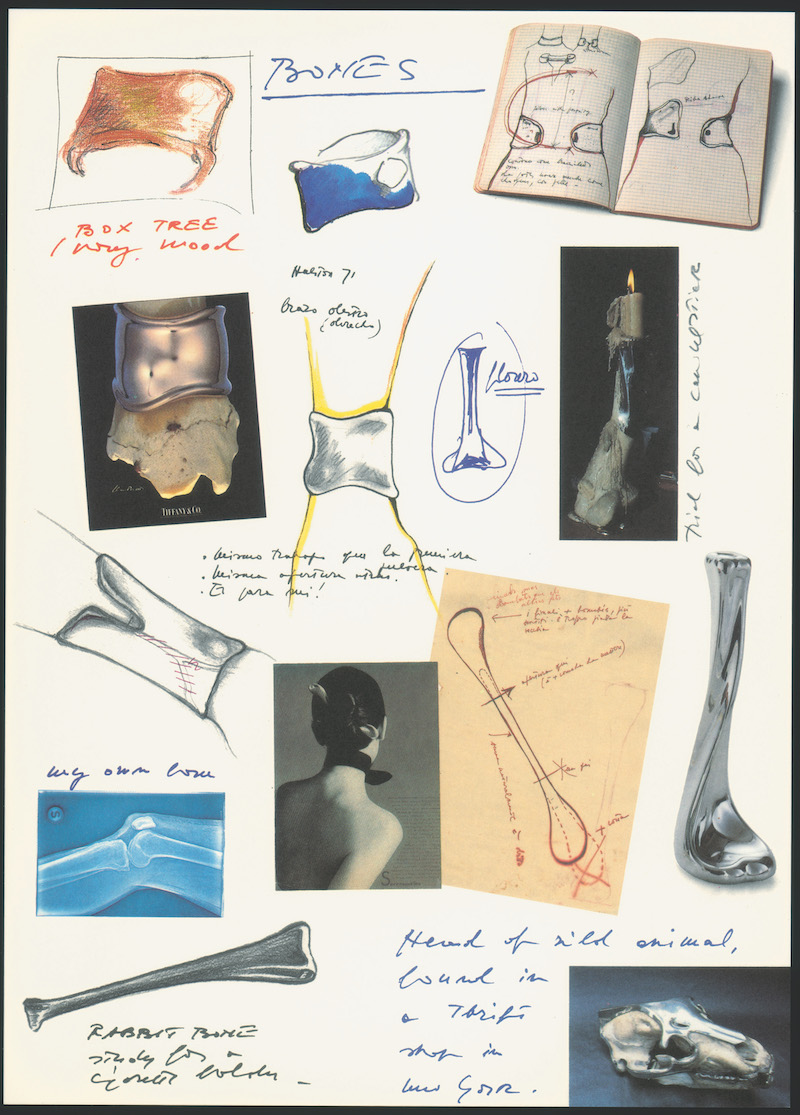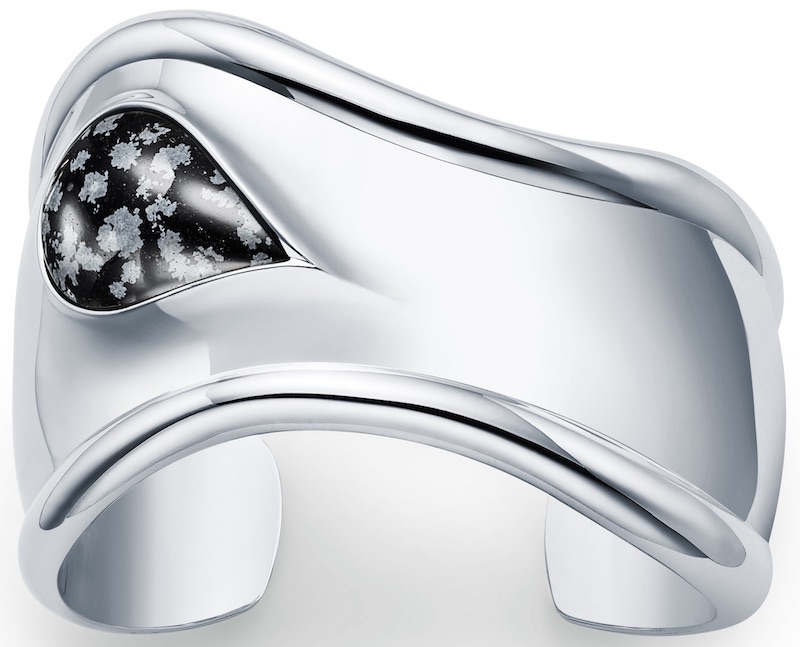Cuffing season: Tiffany & Co. celebrates Peretti’s Bone cuff
The golden anniversary of a revolutionary design
Numbering a minimum total of eight million archived objects, the British Museum’s collections hold many surprises. Along with Neolithic animal remains, a shaman’s amulet carved from an antler tine and a pet cat’s wooden sarcophagus, this historical treasure trove hides an anatomically-shaped find with a difference. Crafted in Italy from polished silver, object number 2007,8006.18 is in fact a piece of contemporary jewellery produced by American brand Tiffany & Co. and dreamed up by Elsa Peretti.
The Italian designer’s Bone cuff forms part of a group of 30 Peretti creations that the London museum acquired in 2009. This collection includes a Japanese hardwood hairpin lacquered gold, a teardrop-shaped medallion pendant and a clear rock-crystal perfume flacon carved by Hong Kong artisans.
Peretti joined Tiffany & Co. in 1974, and her Bone cuff - which the designer had finished four years earlier - featured in her debut collection for the luxury brand. Its design and make-up proved revolutionary. When it came to moulding her cuff, Peretti had championed the use of sterling silver, which was then a rarely used alloy in fine jewellery despite being more affordable than gold. Jewellery lovers embraced her pioneering approach, with Tiffany & Co. ringing up the till for customers including Liza Minnelli, who was guided by her friend, fashion designer Halston. His advice was that “you can’t afford gold, and men have to give you diamonds, so you’re going to wear silver”.
The Week
Escape your echo chamber. Get the facts behind the news, plus analysis from multiple perspectives.

Sign up for The Week's Free Newsletters
From our morning news briefing to a weekly Good News Newsletter, get the best of The Week delivered directly to your inbox.
From our morning news briefing to a weekly Good News Newsletter, get the best of The Week delivered directly to your inbox.
Peretti had also rebelled against traditional with the Bone cuff’s pared-back finish, in a period dominated by gem-set, ornamental finery. The cuff’s anatomical curved outline encases the wearer’s wrists - separate versions are sculpted to fit either the left or right wrist - and a circular rise gives space for the nodule-like ending of the arm’s ulna bone.
To Peretti, the Bone cuff is highly personal: its inspirations stem from the Italian creative’s biography. Peretti was born in Florence but was educated in Rome and Switzerland. Memories of childhood visits to the crypt of a 17th-century Capuchin church in Rome that featured walls decorated with bones were a key source of inspiration when sketching the cuff. Also on her moodboards were images of the undulating walls of Casa Milà, the last private residence that Catalan architect Antoni Gaudí mapped out for this hometown of Barcelona.

Peretti had lived in Barcelona in the early 1960s while working as a model, following previous stints as an Italian language teacher, ski instructor and trainee to a Milanese interior designer. From Barcelona, she crossed the Atlantic to arrive in New York in 1968. Here, her career took off.
Peretti had begun making jewellery during her modelling years, with her early creations including vase-like pendants inspired by bud vases that she found at flea markets. The design would later appear on the runway of Giorgio di Sant’ Angelo. For Halston, Peretti authored pale ivory amulets and horseshoe belt buckles. Her work garnered the attention of many, including Tiffany & Co.
A free daily email with the biggest news stories of the day – and the best features from TheWeek.com
Her subsequent designs for the New York City-based brand are noted for their sensual interaction with the human form. Her tactile second-skin Mesh necklaces are a joy to touch and drape harmoniously against the wearer’s skin; while the chain necklace of her best-selling Bean measure 18in, calculated to centre on clavicles. Elsewhere, her approach is that of a sculptor, manipulating her materials - jade, lacquer and rattan count among Peretti’s favoured mediums, along with silver — to shape organic forms.
Her Bone cuff is viewed by many as her finest creation, however. To celebrate the 50th anniversary of the revolutionary design, Tiffany & Co. has issued new styles of Peretti’s anatomical gem. In May, the brand unveiled a trio of vibrantly finished designs - green, red and blue - made from lightweight copper. Cuffs finessed with hand-set carved stones, including white, black or green jade, golden-hued tiger’s eye and turquoise, followed this September.
When the British Museum added Peretti’s creations to its collection, it did so to highlight the many relationships between designers, brands - in this case, Tiffany & Co. - and specialist makers, and how these ties can extend across cultures and borders. The institution’s selection also includes a red lacquer minaudière bag; a bean-shaped accessory carved from hardwood by artisans working in the Japanese city of Wajima. Japanese artisanship has long influenced Peretti’s work too, and in a nod to this inspiration, Tiffany & Co. has collaborated with experiential retailer Dover Street Market on a special-edition Bone cuff (below) fitted with densely-surfaced snowflake obsidian that will be available until January.
“Dover Street Market’s curated style edit, and the iconic collaborations it is known for, makes it the ideal partner for Elsa Peretti’s timeless Bone cuffs,” says Reed Krakoff, Tiffany & Co.’s chief artistic officer. “It’s a great way to expose the pieces to new consumers who value unique design and style.”

-
 Venezuela’s Trump-shaped power vacuum
Venezuela’s Trump-shaped power vacuumIN THE SPOTLIGHT The American abduction of Venezuelan President Nicolás Maduro has thrust South America’s biggest oil-producing state into uncharted geopolitical waters
-
 Most data centers are being built in the wrong climate
Most data centers are being built in the wrong climateThe explainer Data centers require substantial water and energy. But certain locations are more strained than others, mainly due to rising temperatures.
-
 ‘Maps are the ideal metaphor for our models of what the world might be’
‘Maps are the ideal metaphor for our models of what the world might be’Instant Opinion Opinion, comment and editorials of the day